Abstract
The association of foreign antigen with Ia molecules on the surface of antigen-presenting cells is necessary for the interaction with the clonally distributed antigen receptor on T cells and is therefore critical in the initiation and regulation of immune responses. Ia polypeptides (alpha and beta) are composed of two extracellular domains, a transmembrane domain and a cytoplasmic domain. Although exon-shuffling experiments have demonstrated that antigen associates with the NH2-terminal alpha 1 and beta 1 domains, the roles that the other domains play in Ia function are still poorly understood. The B-hybridoma cell line 2B1 was selected in a series of positive and negative immunoselection steps for a mutation in the Ek alpha polypeptide. It was found to fortuitously contain a mutation in the Ak alpha polypeptide as well. Sequence analysis of the Ak alpha gene showed that a single base transition (C----T) resulted in a stop codon at amino acid residue 222. This caused the loss of 12 amino acids from the cytoplasmic domain of the mature polypeptide. This mutation results in a decreased level of Ak alpha polypeptide expression on the cell surface (50% of wild-type levels), an increased half-life of Ak alpha polypeptide in the cell, and a specific limited defect in antigen presentation.
Full text
PDF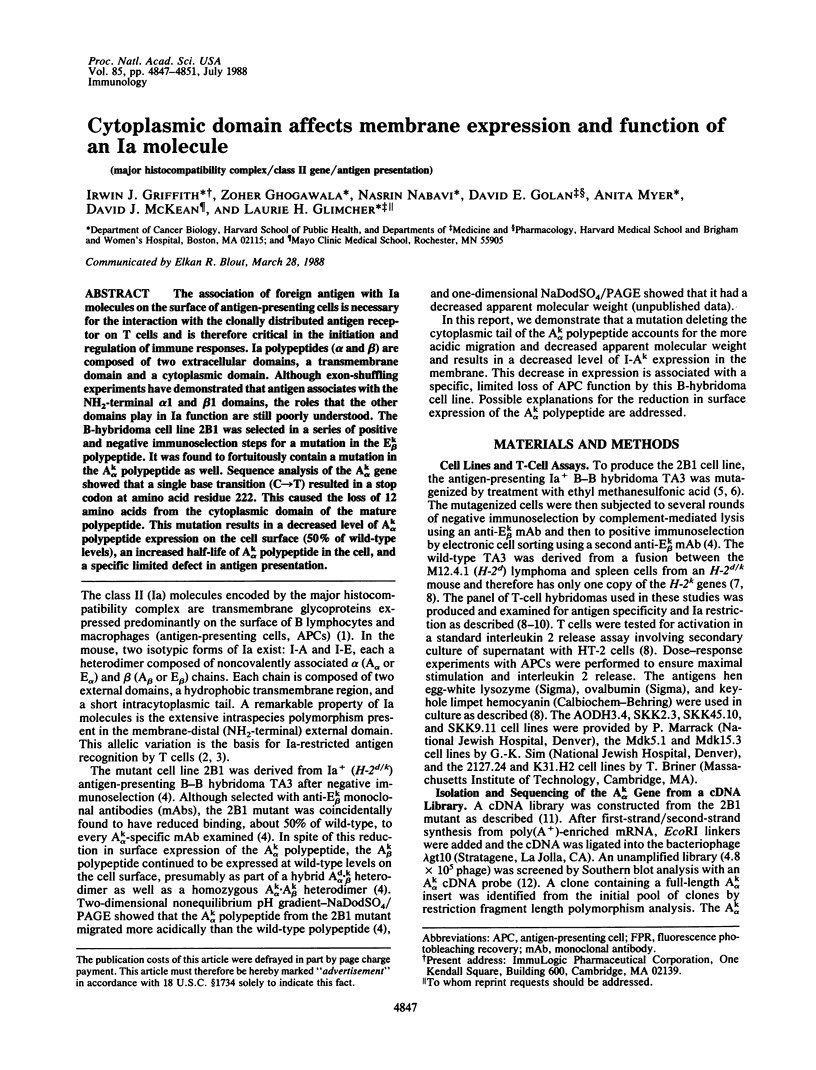
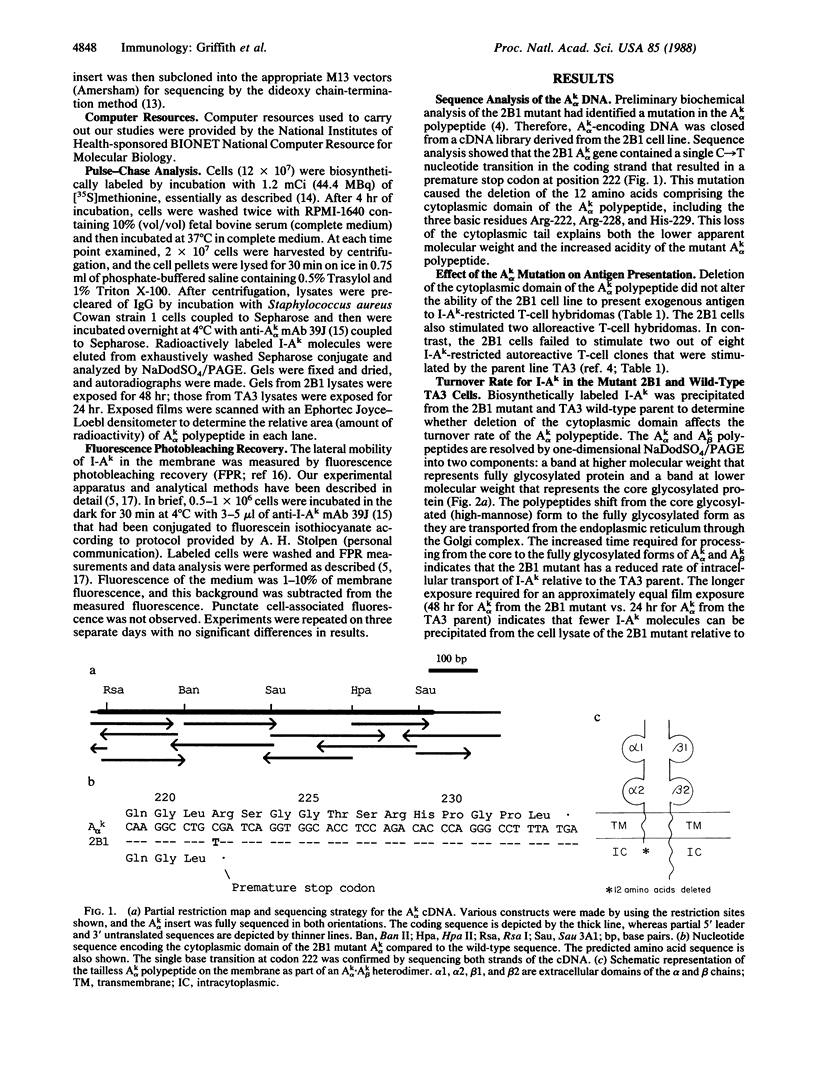
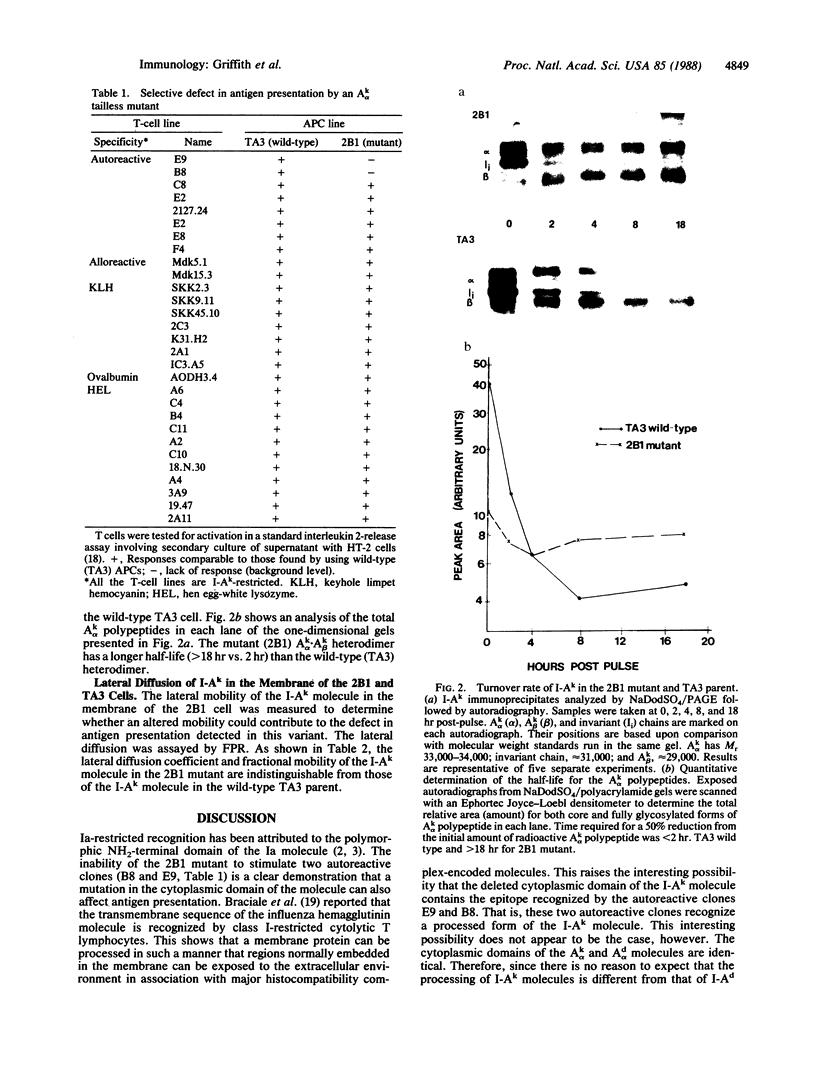
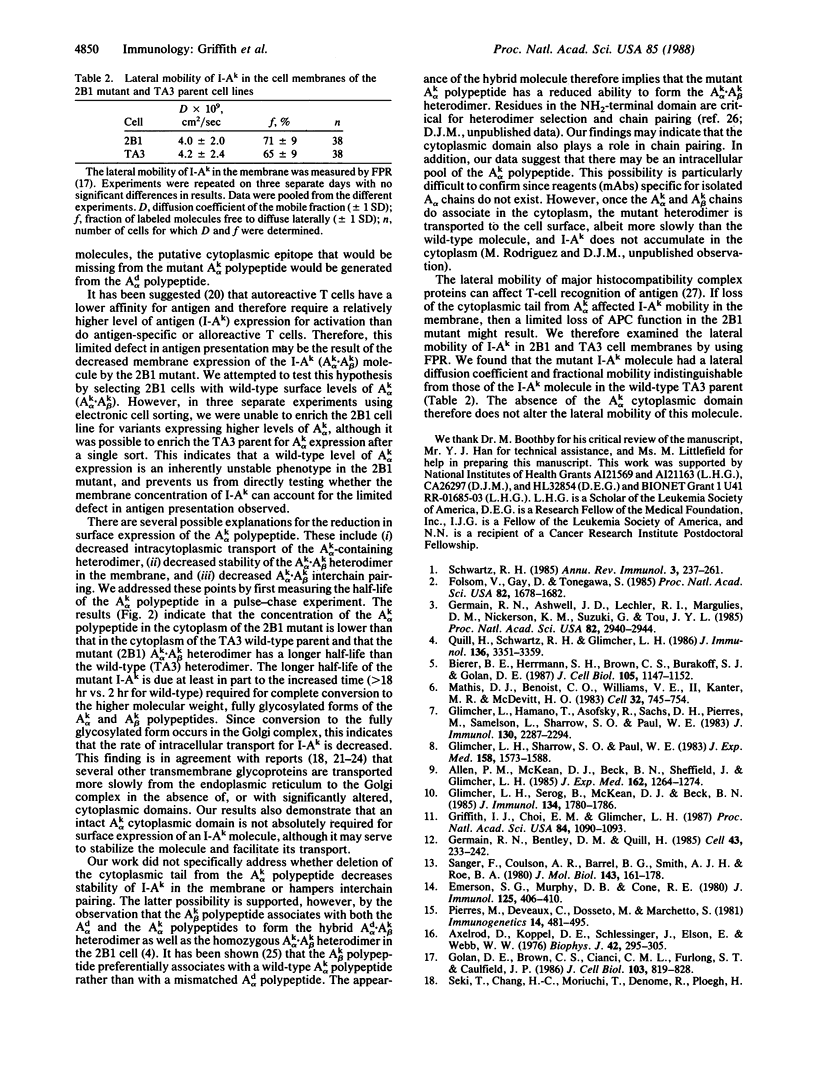
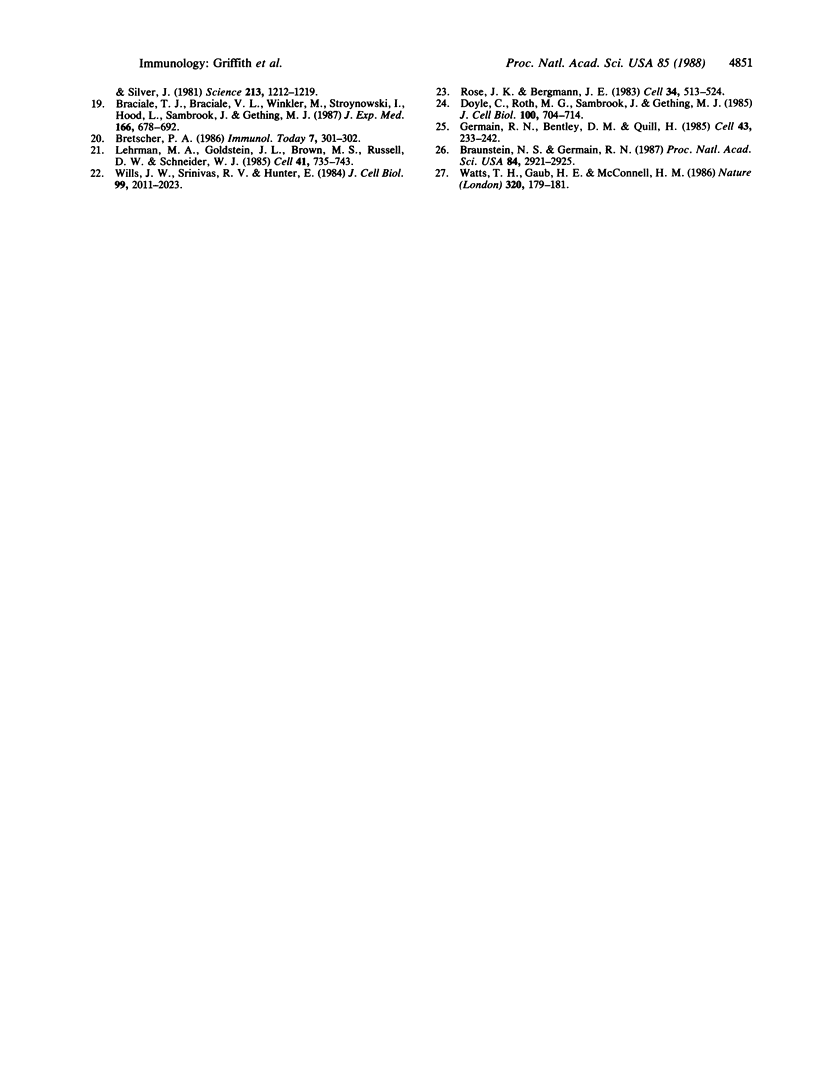
Images in this article
Selected References
These references are in PubMed. This may not be the complete list of references from this article.
- Allen P. M., McKean D. J., Beck B. N., Sheffield J., Glimcher L. H. Direct evidence that a class II molecule and a simple globular protein generate multiple determinants. J Exp Med. 1985 Oct 1;162(4):1264–1274. doi: 10.1084/jem.162.4.1264. [DOI] [PMC free article] [PubMed] [Google Scholar]
- Bierer B. E., Herrmann S. H., Brown C. S., Burakoff S. J., Golan D. E. Lateral mobility of class I histocompatibility antigens in B lymphoblastoid cell membranes: modulation by cross-linking and effect of cell density. J Cell Biol. 1987 Sep;105(3):1147–1152. doi: 10.1083/jcb.105.3.1147. [DOI] [PMC free article] [PubMed] [Google Scholar]
- Braciale T. J., Braciale V. L., Winkler M., Stroynowski I., Hood L., Sambrook J., Gething M. J. On the role of the transmembrane anchor sequence of influenza hemagglutinin in target cell recognition by class I MHC-restricted, hemagglutinin-specific cytolytic T lymphocytes. J Exp Med. 1987 Sep 1;166(3):678–692. doi: 10.1084/jem.166.3.678. [DOI] [PMC free article] [PubMed] [Google Scholar]
- Braunstein N. S., Germain R. N. Allele-specific control of Ia molecule surface expression and conformation: implications for a general model of Ia structure-function relationships. Proc Natl Acad Sci U S A. 1987 May;84(9):2921–2925. doi: 10.1073/pnas.84.9.2921. [DOI] [PMC free article] [PubMed] [Google Scholar]
- Doyle C., Roth M. G., Sambrook J., Gething M. J. Mutations in the cytoplasmic domain of the influenza virus hemagglutinin affect different stages of intracellular transport. J Cell Biol. 1985 Mar;100(3):704–714. doi: 10.1083/jcb.100.3.704. [DOI] [PMC free article] [PubMed] [Google Scholar]
- Emerson S. G., Murphy D. B., Cone R. E. Ia antigen turnover. II. The kinetics of biosynthesis and release of Ia alpha- and beta-chains by murine spleen cells in culture. J Immunol. 1980 Jul;125(1):406–410. [PubMed] [Google Scholar]
- Folsom V., Gay D., Tonegawa S. The beta 1 domain of the mouse E beta chain is important for restricted antigen presentation to helper T-cell hybridomas. Proc Natl Acad Sci U S A. 1985 Mar;82(6):1678–1682. doi: 10.1073/pnas.82.6.1678. [DOI] [PMC free article] [PubMed] [Google Scholar]
- Germain R. N., Ashwell J. D., Lechler R. I., Margulies D. H., Nickerson K. M., Suzuki G., Tou J. Y. "Exon-shuffling" maps control of antibody- and T-cell-recognition sites to the NH2-terminal domain of the class II major histocompatibility polypeptide A beta. Proc Natl Acad Sci U S A. 1985 May;82(9):2940–2944. doi: 10.1073/pnas.82.9.2940. [DOI] [PMC free article] [PubMed] [Google Scholar]
- Germain R. N., Bentley D. M., Quill H. Influence of allelic polymorphism on the assembly and surface expression of class II MHC (Ia) molecules. Cell. 1985 Nov;43(1):233–242. doi: 10.1016/0092-8674(85)90028-5. [DOI] [PubMed] [Google Scholar]
- Germain R. N., Bentley D. M., Quill H. Influence of allelic polymorphism on the assembly and surface expression of class II MHC (Ia) molecules. Cell. 1985 Nov;43(1):233–242. doi: 10.1016/0092-8674(85)90028-5. [DOI] [PubMed] [Google Scholar]
- Glimcher L. H., Hamano T., Asofsky R., Sachs D. H., Pierres M., Samelson L. E., Sharrow S. O., Paul W. E. IA mutant functional antigen-presenting cell lines. J Immunol. 1983 May;130(5):2287–2294. [PubMed] [Google Scholar]
- Glimcher L. H., Serog B., McKean D. J., Beck B. N. Evidence that autoreactive T hybridomas recognize multiple epitopes on the I-Ak molecule. J Immunol. 1985 Mar;134(3):1780–1786. [PubMed] [Google Scholar]
- Glimcher L. H., Sharrow S. O., Paul W. E. Serologic and functional characterization of a panel of antigen-presenting cell lines expressing mutant I-A class II molecules. J Exp Med. 1983 Nov 1;158(5):1573–1588. doi: 10.1084/jem.158.5.1573. [DOI] [PMC free article] [PubMed] [Google Scholar]
- Golan D. E., Brown C. S., Cianci C. M., Furlong S. T., Caulfield J. P. Schistosomula of Schistosoma mansoni use lysophosphatidylcholine to lyse adherent human red blood cells and immobilize red cell membrane components. J Cell Biol. 1986 Sep;103(3):819–828. doi: 10.1083/jcb.103.3.819. [DOI] [PMC free article] [PubMed] [Google Scholar]
- Griffith I. J., Choi E. M., Glimcher L. H. A single base mutation in an I-A alpha-chain gene alters T-cell recognition. Proc Natl Acad Sci U S A. 1987 Feb;84(4):1090–1093. doi: 10.1073/pnas.84.4.1090. [DOI] [PMC free article] [PubMed] [Google Scholar]
- Lehrman M. A., Goldstein J. L., Brown M. S., Russell D. W., Schneider W. J. Internalization-defective LDL receptors produced by genes with nonsense and frameshift mutations that truncate the cytoplasmic domain. Cell. 1985 Jul;41(3):735–743. doi: 10.1016/s0092-8674(85)80054-4. [DOI] [PubMed] [Google Scholar]
- Mathis D. J., Benoist C. O., Williams V. E., 2nd, Kanter M. R., McDevitt H. O. The murine E alpha immune response gene. Cell. 1983 Mar;32(3):745–754. doi: 10.1016/0092-8674(83)90060-0. [DOI] [PubMed] [Google Scholar]
- Pierres M., Devaux C., Dosseto M., Marchetto S. Clonal analysis of B- and T-cell responses to Ia antigens. I. Topology of epitope regions on I-Ak and I-Ek molecules analyzed with 35 monoclonal alloantibodies. Immunogenetics. 1981 Dec;14(6):481–495. doi: 10.1007/BF00350120. [DOI] [PubMed] [Google Scholar]
- Quill H., Schwartz R. H., Glimcher L. H. Ek beta mutant antigen-presenting cell lines expressing altered Ak alpha molecules. J Immunol. 1986 May 1;136(9):3351–3359. [PubMed] [Google Scholar]
- Rose J. K., Bergmann J. E. Altered cytoplasmic domains affect intracellular transport of the vesicular stomatitis virus glycoprotein. Cell. 1983 Sep;34(2):513–524. doi: 10.1016/0092-8674(83)90384-7. [DOI] [PubMed] [Google Scholar]
- Sanger F., Coulson A. R., Barrell B. G., Smith A. J., Roe B. A. Cloning in single-stranded bacteriophage as an aid to rapid DNA sequencing. J Mol Biol. 1980 Oct 25;143(2):161–178. doi: 10.1016/0022-2836(80)90196-5. [DOI] [PubMed] [Google Scholar]
- Schwartz R. H. T-lymphocyte recognition of antigen in association with gene products of the major histocompatibility complex. Annu Rev Immunol. 1985;3:237–261. doi: 10.1146/annurev.iy.03.040185.001321. [DOI] [PubMed] [Google Scholar]
- Watts T. H., Gaub H. E., McConnell H. M. T-cell-mediated association of peptide antigen and major histocompatibility complex protein detected by energy transfer in an evanescent wave-field. Nature. 1986 Mar 13;320(6058):179–181. doi: 10.1038/320179a0. [DOI] [PubMed] [Google Scholar]
- Wills J. W., Srinivas R. V., Hunter E. Mutations of the Rous sarcoma virus env gene that affect the transport and subcellular location of the glycoprotein products. J Cell Biol. 1984 Dec;99(6):2011–2023. doi: 10.1083/jcb.99.6.2011. [DOI] [PMC free article] [PubMed] [Google Scholar]




